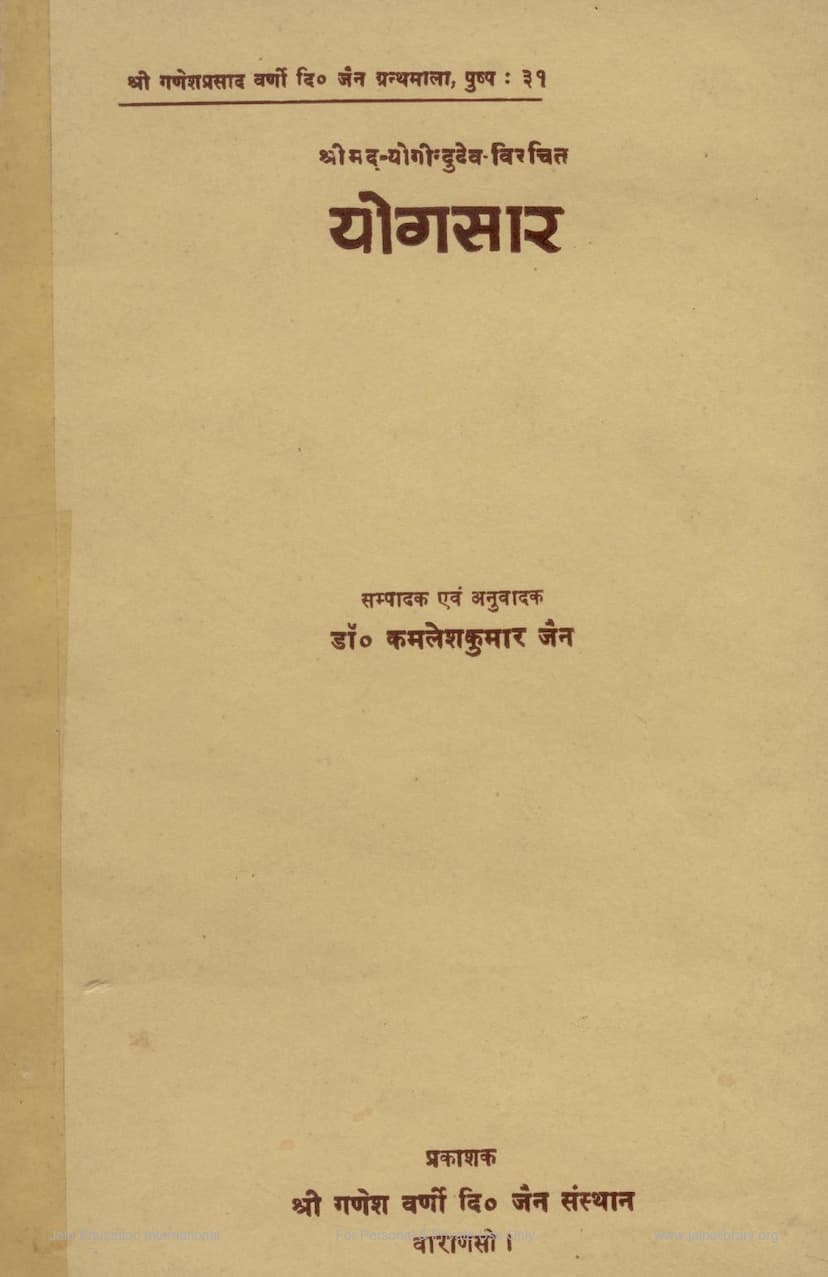Yogasara
Added to library: September 2, 2025

Summary
Here's a comprehensive summary of the Jain text "Yogasara," based on the provided pages:
Book Title: Yogasara (योगसार) Author: Yogindradeva (योगीन्दुदेव), also referred to as Jogichand (जोगिचंद). Publisher: Shri Ganesh Varni Digambar Jain Sansthan, Varanasi. Edition: First Edition, 1987 AD (V.N.S. 2514). Language: Apabhramsha (the original text), with a Deshabhasha Vachanika (vernacular commentary) by Pt. Pannalal Chaudhari and a Hindi translation by Dr. Kamalesh Kumar Jain.
Overview:
"Yogasara" is a significant spiritual and philosophical work composed in Apabhramsha, a Prakrit language. It is considered one of the earliest and most influential texts in the genre of Jain mystical poetry. The book focuses on the essence of yoga (spiritual practice and union), which in the Jain context, means the realization of the soul's true nature. The edition under review is particularly valuable as it includes the first publication of the Deshabhasha Vachanika, providing an accessible explanation of the original text.
Author and Time Period:
Yogindradeva (Yogindu) is believed to have lived around the 6th century AD, although scholarly opinions vary. He is also known as Jogichand. His works, including "Paramatm Prakash" and "Yogasara," show the influence of earlier Jain Acharyas like Kundakunda and Pujyapada. Yogindradeva's writings are praised for their profound spiritual content, simple yet impactful language, and focus on the ultimate reality of the soul.
Key Themes and Content:
The "Yogasara" is structured around the core tenets of Jain philosophy, particularly the path to liberation (moksha). Its primary themes include:
-
The Nature of the Soul (Atman): The text emphasizes the soul as the true self, distinct from the body and other material substances. It describes the soul in its pure, liberated state as omniscient, omnipotent, and blissful.
-
The Three Aspects of the Soul: Yogindradeva categorizes the soul into three forms:
- Bahiratma (Outer Soul): The soul identified with the physical body and external worldly attachments. It is deluded by ignorance.
- Antaratma (Inner Soul): The soul that begins to discern the true self from the non-self and engages in spiritual practices.
- Paramatma (Supreme Soul): The liberated soul, free from all karmic bondage, possessing infinite knowledge, perception, bliss, and energy.
-
The Path to Liberation (Moksha): The book outlines the Jain path to liberation, which involves:
- Right Faith (Samyak Darshan): True understanding and belief in the Jain principles.
- Right Knowledge (Samyak Gyan): Correct knowledge of the soul and reality.
- Right Conduct (Samyak Charitra): Ethical behavior and adherence to vows, culminating in the four types of spiritual conduct (Samayik, Chedopasthapana, Pariharvishuddhi, Sukshma Samparaya).
- Meditation (Dhyana): The practice of concentrating the mind on the pure soul to overcome karmic obstacles.
-
Distinction between Nayas (Perspectives): The text highlights the importance of understanding reality from different perspectives, particularly:
- Nishchaya Naya (Ultimate Perspective): Focuses on the inherent nature of the soul, asserting that the soul is inherently pure, liberated, and identical to the liberated beings (Siddhas) and even the Tirthankaras.
- Vyavahara Naya (Conventional Perspective): Deals with the empirical reality, including the cycle of birth and death, karmic bondage, and the stages of spiritual progress (Gun Sthanas).
-
Critique of Ritualism: "Yogasara" strongly criticizes the reliance on external rituals, penances, and scriptural study without genuine self-realization. It asserts that these practices are meaningless without the realization of the true nature of the soul.
-
Anicca (Impermanence) and Asharan (Lack of Refuge): The text discusses the impermanence of worldly things and the fact that external entities cannot provide ultimate refuge. Only the soul itself is the true refuge.
-
On Deities and Temples: Yogindradeva makes a significant point that the true "dev" (divine being or soul) resides within the body-temple, not in external temples or idols. This emphasizes the internal nature of spiritual realization.
The Commentary (Vachanika):
The Deshabhasha Vachanika by Pt. Pannalal Chaudhari provides a verse-by-verse explanation of the Apabhramsha verses. It clarifies the meaning of the verses, defines technical terms, and elaborates on the philosophical concepts presented. The commentary is written in a vernacular dialect, making the profound teachings of "Yogasara" accessible to a wider audience.
Key Messages:
- True religion lies in the renunciation of passion (rag-dwesh) and dwelling in the self.
- External rituals are fruitless without inner realization.
- The soul is the only true refuge and the path to liberation lies within.
- One must discriminate between the soul (conscious) and non-soul (unconscious) elements.
- The ultimate goal is the realization of the soul's inherent pure and blissful nature (Paramatma).
Significance of this Edition:
This edition, edited and translated by Dr. Kamalesh Kumar Jain, is important for several reasons:
- It makes the ancient text of "Yogasara" available with a critical apparatus.
- It includes the previously unpublished Deshabhasha Vachanika, greatly enhancing the accessibility of the text.
- It provides a clear Hindi translation, further broadening its reach.
- The editorial work includes detailed introductions, textual analysis, and discussions on the author and the text's history, making it a valuable academic and spiritual resource.
In essence, "Yogasara" is a timeless spiritual guide that directs the seeker towards self-realization, emphasizing the power of inner contemplation and detachment from the external world to achieve ultimate liberation.